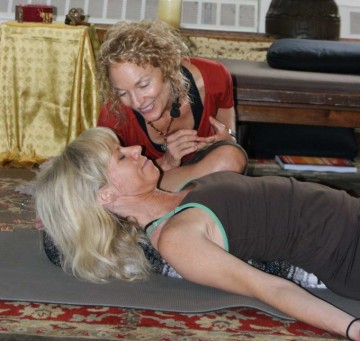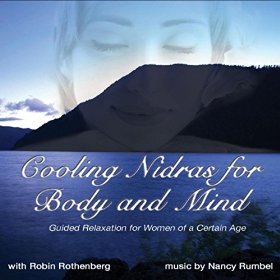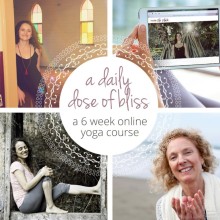 If meditation helps us observe rather than react to our life experiences, does it run the risk of making us less compassionate? In this issue, we write about a study that attends to the subtler effects of meditation. Through the lens of brain science, Dr. Shirley Telles and her colleagues examine this question, considering if detachment and empathy can co-exist or might even be complementary benefits of meditation practice. We also report on another prenatal yoga study coming from Brown University and Butler Hospital with encouraging news for pregnant women suffering from depression.
If meditation helps us observe rather than react to our life experiences, does it run the risk of making us less compassionate? In this issue, we write about a study that attends to the subtler effects of meditation. Through the lens of brain science, Dr. Shirley Telles and her colleagues examine this question, considering if detachment and empathy can co-exist or might even be complementary benefits of meditation practice. We also report on another prenatal yoga study coming from Brown University and Butler Hospital with encouraging news for pregnant women suffering from depression.
What I’m thrilled to tell you about is the ongoing collaboration between LifeForce Yoga and Internal Family Systems. Laura Orth and Liz Brenner, clinical social workers, IFS therapists and senior LifeForce Yoga practitioners will be joining me at Kripalu over Memorial Day weekend to explore how LifeForce yoga and IFS can help unburden those anxious parts!
I’m writing from Yogaville in Buckingham, VA, where the trees are in bud and the daffodils are blooming in abundance. We’re in the midst of our level one LifeForce Yoga Practitioner Training, open to all serious students of yoga. You missed the sign up for this one, but we have online and residential LFYP Trainings all year to which you’re welcome to apply, either for personal growth or certification.
RESEARCH: Yoga as Treatment nearly doubled since 2002
 Yoga Therapeutics is increasing as more Americans are seeking yoga treatment than ever before. Every five years NIH’s National Center for Complementary and Integrative Health (NCCIH) and the Centers for Disease Control and Prevention’s National Center for Health Statistics (NCHS) conduct a survey, interviewing over one hundred thousand adults and adults knowledgeable about children aged 4 -17 year to determine their use of complementary health approaches. NCCIH noted that there has been a significant increase in the use of yoga since 2002. In addition, more Americans practice yoga than receive chiropractic or osteopathic manipulation, and almost as many Americans practice meditation.
Yoga Therapeutics is increasing as more Americans are seeking yoga treatment than ever before. Every five years NIH’s National Center for Complementary and Integrative Health (NCCIH) and the Centers for Disease Control and Prevention’s National Center for Health Statistics (NCHS) conduct a survey, interviewing over one hundred thousand adults and adults knowledgeable about children aged 4 -17 year to determine their use of complementary health approaches. NCCIH noted that there has been a significant increase in the use of yoga since 2002. In addition, more Americans practice yoga than receive chiropractic or osteopathic manipulation, and almost as many Americans practice meditation.
Here are the highlights from the survey:
- Approximately 21 million adults (nearly double the number from 2002) and 1.7 million children practiced yoga
- Nearly 20 million adults and 1.9 million children had chiropractic or osteopathic manipulation
- Nearly 18 million adults and 927,000 children practiced meditation
- Children whose parents use a complementary health approach are more likely to use one as well
The increase in yoga has occurred across all age, racial, and ethnic groups. Most notably, the largest shift in the use of any mind and body approach was seen in the demographics of people using yoga:
- Among Americans age 18-44, yoga use nearly doubled since 2002
- Among older Americans age 45-64, usage increased from 5.2 percent in 2002 to 7.2 percent in 2012
- Approximately 400,000 more children aged 4-17 used yoga in 2012 than in 2007
The high rates of use may be partly due to a growing body of research showing that some mind and body practices can help manage pain and reduce stress. Another factor that may have influenced the increased popularity of yoga is increased access — for instance, industry reports show that the number of yoga studios in the United States has increased substantially in recent years.
“The 2012 NHIS survey is the most current, comprehensive, and reliable source of information on the use of complementary health approaches by U.S. adults and children. The survey data suggest that consumers are paying attention to medical evidence and using it to inform their decisions,” said Josephine P. Briggs, M.D., Director of NCCIH. “This reaffirms how important it is for NIH to rigorously study complementary health approaches and make that information easily available to consumers.”
This bodes well for NCCIH funding for future yoga research, as growing use is one of the four guiding principles that determine the practices and products studied by NCCIH. The others are that the practice or product must be able to be studied using high-quality and rigorous research, hold promise, and have an impact on the public’s health. Since Americans often turn to complementary health approaches to address chronic pain, NCCIH can make yoga research a priority, since so many, according to the NCCIH findings, are finding benefits in the management of pain that, according to the NCCIH, “are not consistently addressed well by drugs and other conventional treatments.”
RESEARCH: Yoga as an Anti-Depressant Treatment for Pregnant Women
 Many women who suffer from depression are reluctant to take medication during pregnancy, often because they understand that antidepressants and other psycho-pharmacologic agents can affect the fetus. Previous research by the authors of this current study has found that pregnant women who are new to yoga are both interested and open to trying it as an intervention to help them manage their mood.
Many women who suffer from depression are reluctant to take medication during pregnancy, often because they understand that antidepressants and other psycho-pharmacologic agents can affect the fetus. Previous research by the authors of this current study has found that pregnant women who are new to yoga are both interested and open to trying it as an intervention to help them manage their mood.
In this study undertaken by researchers at Brown University and Butler Hospital, funded by the National Institute of Mental Health and published in the March-April, 2015 issue of the journal Women’s Health Issues, a 10-week program of prenatal yoga, was found to be “feasible, acceptable, safe, and effective for mild to moderately depressed women.”
Kaeli Sutton, who has advanced training in both prenatal massage and yoga, co-directs a nonprofit specializing in wellness and education for families and has worked with over 1800 mothers and families, designed the yoga protocol. Prenatal yoga classes occurred twice per week, with one daytime class and one evening class offered, although the researchers understood that most women would only be able to attend once per week. The women received a yoga mat and a prenatal yoga DVD for home practice. According to the authors, the 75-minute classes were “gentle in nature, and designed to be safe for pregnant women, including frequent use of props and modifications of poses.” Each class included an opening greeting; pranayama, breath awareness or meditation; a warm-up that included gentle, breath-linked movement; standing poses; floor poses; a final resting pose; pranayama or meditation; and a brief class closing.
The 34 women who participated saw their depressive symptoms decline during the 10-week program on two standardized scales. On the “QIDS” scale, in which a trained, objective rater evaluates responses, the women on average dropped from scores consistent with moderate depression (10-15) to scores well into the mild range (5-10). On the “EPDS” scale, which relies on self-reports, average scores fell similarly, from a level consistent with clinically significant depression (more than 10) to scores significantly under that threshold. The study data also showed that the more prenatal yoga pregnant women did, the more they benefitted psychologically. It’s the first study showing a proportional association.
“We’ve learned from this open pilot trial,” said lead investigator Cynthia Battle, “that prenatal yoga really does appear to be an approach that is feasible to administer, acceptable to women and their healthcare providers, and potentially helpful to improve mood.” She and second author Lisa Uebelacker have since led a small randomized controlled trial with similarly positive results that are now being written up for publication.
There was no control group to measure against, so as Battle explains, “This is not the definitive study where we can say that this is an efficacious frontline treatment, however it is a study suggesting that we know enough now to warrant the next, larger study.”
With the increased use of yoga as a complementary treatment by the American public, as documented in the previous newsletter article, combined with several pilot studies by this team indicating the acceptance and efficacy of yoga for prenatal depression, we would hope that funds for further research by Battle and her colleagues will be forthcoming.
To read an article about the study visit: https://news.brown.edu/articles/2015/03/pregnant.
RESEARCH Wisdom: Dispassion and Compassion—Can they Co-Exist?
 When we meditate, we are cultivating an ability to witness without reacting to our ongoing experiences. In so doing, are we less likely to feel our feelings? Are we less likely to respond to circumstances that call for compassionate action, whether towards ourselves, others, or the environment? For the first time, researchers have given us a review of literature that analyzes brain activity during different meditation techniques with some of these questions in mind. The review was done by senior researcher Shirley Telles, PhD, and her colleagues, in order to determine if “detachment,” defined in this study as “reducing or removing the need to control, possess, and be influenced by the actions of people or circumstances,” and “empathy” can co-exist in meditation.
When we meditate, we are cultivating an ability to witness without reacting to our ongoing experiences. In so doing, are we less likely to feel our feelings? Are we less likely to respond to circumstances that call for compassionate action, whether towards ourselves, others, or the environment? For the first time, researchers have given us a review of literature that analyzes brain activity during different meditation techniques with some of these questions in mind. The review was done by senior researcher Shirley Telles, PhD, and her colleagues, in order to determine if “detachment,” defined in this study as “reducing or removing the need to control, possess, and be influenced by the actions of people or circumstances,” and “empathy” can co-exist in meditation.
There is a beautiful aphorism that speaks to this question from the great Vedanta sage, Sri Nisargadatta. He said:
When I look inside and see that I am nothing, that is wisdom.
When I look outside and see that I am everything, that is love.
Between these two, my world turns.
In this meta-analysis, the researchers looked at ten neuroimaging studies with 91 meditators and determined that there was a common neural network affected by different techniques whose common goal is to “induce relaxation, regulate attention and develop detachment from one’s thoughts.” In most of the techniques tested, changes occurred in the activity of the medial prefrontal cortex (MPFC) that are associated with reduced task activity and increased interospection activity. Interoception refers to our ability to tune into and observe what is happening within the body–sensations from our organs and muscles, hunger, thirst, how we are breathing. Interoception is our ability to feel fully present in our bodies. The changes indicating reduced task activity and increased interospection were noted in the dorsal (posterior or back) of the MPFC.
In one study that looked at five types of meditation, there was a reduced interaction between areas of the brain that observed and areas of the brain that judged. According to the researchers, “The reduction was possibly related to minimized interaction between the self process functions (described as including self-awareness, autobiographic memory, agency and embodiment) and constraints on the self-process, leading to non-involvement and detachment. Detachment can help an individual to get mental peace.” But what happens to our ability to empathically connect with others, when we are “detached”? “In order to contribute usefully to society,” say the researchers (and most thinking/feeling adults), “empathy and compassion are essential.”
In their analysis of the data, the researchers determined that the medial prefrontal cortex (MPFC), not only regulates detachment, but it also regulates empathy. In data from studies that look at compassion meditation and loving kindness meditation, one of the areas affected by these meditations is the ventral MPFC. This is the front area (anterior) of the brain that is responsible for our executive functioning.
In addition, Loving Kindness Meditation and Compassion Meditation activate the emotional area of the brain, the limbic system, through an activation of the amygdala. Both the dorsal MPFC, associated with detachment, and the ventral MPFC, associated with empathy are connected through the amygdala, suggesting, according to the researchers, that both detachment and compassion are closely related areas of the brain.
So perhaps, from a brain science point of view on Sri Nisargadatta’s quote above, our inner world turns from detachment to empathy in the amygdala.
Although they call for further research, the authors of this analytical review speculate “that through meditation an individual can reach a mental state which is disengaged and detached, but retains the choice to engage with specific situations based on compassion.”
RESEARCH: Consensus-based Protocols for Yoga interventions for Depression and Anxiety
 Researchers in Australia asked 33 yoga teachers from four different countries who are established in the field of yoga and mental health for recommendations in using yoga as a treatment for anxiety and depression. I was one of 18 teachers who participated in two rounds of a survey. The first round (24 teachers) was to establish initial views. The second round was to create a consensus on frequency and duration (dosage) of the yoga, approaches and techniques to be included or avoided, and training and experience for yoga teachers. In an article published in BMC Complementary and Alternative Medicine in March, 2015, the authors write that a general consensus of survey participants recommended that for maximum benefit, yoga be practiced an average of 30 to 40 minutes, 5 times per week, over a period of 6 weeks. The key components agreed upon by the survey takers for depression were Breath regulation and postures. Breath regulation and meditation were considered essential for people with anxiety. There was also general consensus that yoga teacher training be at the 500-hour level over two years; that the teacher maintain her own practice, that she take some kind of training in yoga for mental health and receive professional supervision or mentoring.
Researchers in Australia asked 33 yoga teachers from four different countries who are established in the field of yoga and mental health for recommendations in using yoga as a treatment for anxiety and depression. I was one of 18 teachers who participated in two rounds of a survey. The first round (24 teachers) was to establish initial views. The second round was to create a consensus on frequency and duration (dosage) of the yoga, approaches and techniques to be included or avoided, and training and experience for yoga teachers. In an article published in BMC Complementary and Alternative Medicine in March, 2015, the authors write that a general consensus of survey participants recommended that for maximum benefit, yoga be practiced an average of 30 to 40 minutes, 5 times per week, over a period of 6 weeks. The key components agreed upon by the survey takers for depression were Breath regulation and postures. Breath regulation and meditation were considered essential for people with anxiety. There was also general consensus that yoga teacher training be at the 500-hour level over two years; that the teacher maintain her own practice, that she take some kind of training in yoga for mental health and receive professional supervision or mentoring.
A consensus doesn’t mean that there was complete agreement, and in fact there was not a consensus on first meeting the mood with a practice before offering a practice to counter the current mood (practiced in LifeForce Yoga). However, establishing training guidelines for yoga teachers working in the field of mental health, and a list of appropriate practices and contraindications is an important step in offering the healing of yoga to those who suffer from mood disorders. LifeForce Yoga is especially gratefully to lead investigator Michael de Manincor and his colleagues for this important work. To read the study: Establishing key components of yoga interventions for reducing depression and anxiety, and improving well-being: a Delphi method study click here.
REVIEW: Cooling Nidras for Body and Mind: Guided Relaxation for Women of a Certain Age
 Senior Yoga Therapist and teacher trainer, Robin Rothenberg teams up with award-winning composer Nancy Rumbel for a second CD of Yoga Nidra practices. Cooling Nidras was created for a National Institutes of Health (NIH) funded study that looked at the efficacy of using Yoga Nidra, along with yoga asana, for menopausal women suffering from hot flashes. Although hot flashes were not significantly reduced in a population that had more than 28 hot flashes a day, yoga and yoga nidra did show a significant improvement in quality of life factors including sleep and sexuality (libido) as compared to cardio exercise and usual care. Rothenberg says that when she tested out the protocol (She ran three free trials), the overall feedback was that women were sleeping much better and less bothered by hot flashes and felt more in control of their “thermostat.”
Senior Yoga Therapist and teacher trainer, Robin Rothenberg teams up with award-winning composer Nancy Rumbel for a second CD of Yoga Nidra practices. Cooling Nidras was created for a National Institutes of Health (NIH) funded study that looked at the efficacy of using Yoga Nidra, along with yoga asana, for menopausal women suffering from hot flashes. Although hot flashes were not significantly reduced in a population that had more than 28 hot flashes a day, yoga and yoga nidra did show a significant improvement in quality of life factors including sleep and sexuality (libido) as compared to cardio exercise and usual care. Rothenberg says that when she tested out the protocol (She ran three free trials), the overall feedback was that women were sleeping much better and less bothered by hot flashes and felt more in control of their “thermostat.”
There are two 20-minute soothing, cooling practices. In addition to the traditional body scan, breath awareness, and moments of expanded consciousness, the first practice makes use of cool stream and river imagery and a left nostril breathing practice that is cooling and releasing. In the second Nidra practice, Rothenberg’s language is even more beautifully evocative. The practitioner is guided to imagine a cool breeze brushing or fanning across each body party, a shady grove, and being cradled by moist earth. She suggests that the practitioner imagine an inner thermostat, and then guides the raising and lowering, by degree, of the body temperature. Although the shortened protocol, necessitated by the study’s parameters means that Rothenberg did not include the exploration of the opposites of emotion and belief (manomaya kosha and vijnayamaya kosha), I can imagine using this CD, not only for managing hot flashes during menopause, but any time a moment of cool rest would be appreciated. Rumbel’s music gracefully compliments Rothenberg’s words.
I would imagine that once the practitioner is comfortable with the imagery of cool breezes and turning down her thermostat, she may get some relief at the onset of a flashback. However, the practice seems best suited to basic relaxation that can help with sleep, whether we are menopausal or not.
To purchase a copy of the Cooling Nidras CD click here.
News: LFYP and Mentor Joanne Spence Nominated for Yoga Journal Good Karma Award
 We are thrilled to announce that LFYP and Mentor Joanne Spence is one of 13 nominees for the Yoga Journal Good Karma Awards.
We are thrilled to announce that LFYP and Mentor Joanne Spence is one of 13 nominees for the Yoga Journal Good Karma Awards.
Joanne has been teaching yoga full time for 14 years. She has combined LifeForce Yoga with her clinical social work background and works as the first yoga therapist at Western Psychiatric Institute and Clinic, one of the largest inpatient psychiatric hospitals in the US. Joanne is also member of the International Association of Yoga Therapists. In 2004, she founded Yoga in Schools (YIS) as a way to reach school children and teachers to help them nurture their own well-being through yoga. Since then, Yoga in Schools has become a leader in the field of school yoga, reaching over 20,000 children and 1,000 teachers with sustainable wellness programs. Joanne teaches and presents across the US at conferences and retreat centers including Kripalu, Omega and the Garrison Institute.
News: Amy is a Guest Teacher on A Daily Dose of Bliss
 I just wanted to share with you today an online yoga course that I’m guest teaching on. It’s a six week course specifically designed to teach you practices to stay calm, centered and grounded, amidst the ups and downs of daily life. In A Daily Dose of Bliss, you’ll receive a new 5-10 minute practice each day for six weeks. The course was lovingly created by Dr Lauren Tober, a Clinical Psychologist and Yoga Teacher from Byron Bay, Australia. And I’m honored to be joining her a host of internationally acclaimed yoga teachers to help you to find your bliss!
I just wanted to share with you today an online yoga course that I’m guest teaching on. It’s a six week course specifically designed to teach you practices to stay calm, centered and grounded, amidst the ups and downs of daily life. In A Daily Dose of Bliss, you’ll receive a new 5-10 minute practice each day for six weeks. The course was lovingly created by Dr Lauren Tober, a Clinical Psychologist and Yoga Teacher from Byron Bay, Australia. And I’m honored to be joining her a host of internationally acclaimed yoga teachers to help you to find your bliss!
The early bird price is available for just a little while longer. Sign up today!